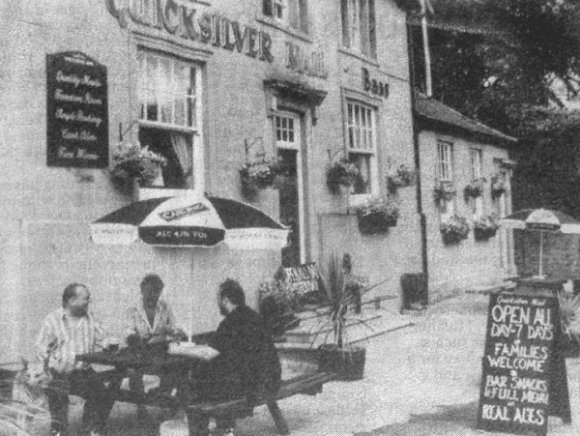the history of yeovil's pubs
PUBS HOME PAGE |
PUBS INTRODUCTION |
PUBS BY NAME |
BEERHOUSES |
Quicksilver Mail
29 Hendford Hill / 168 Hendford Hill
The original Quicksilver Mail was the London to Falmouth Royal Mail Coach, seen in the painting below, that operated between 1835 and 1859. In 1837 it became the fastest long-distance mail coach in England with an average speed of 10.25 miles an hour. The London to Falmouth journey being accomplished in 16 hours and 34 minutes. This time included changes of horses, meals and the transaction of Post Office business. It was the only Royal Mail coach to be named, rather than numbered, and other coaches took its name because of its national renown.
It is not known when the inn was built but it is most likely late eighteenth century and it is shown on the 1811 Ordnance Survey map, (see below). It was certainly an inn by around 1828 since a Notice of Let published in 1848 stated that the Quicksilver Mail was "now and for nearly 20 years past in the occupation of Mr Thomas Bullen".
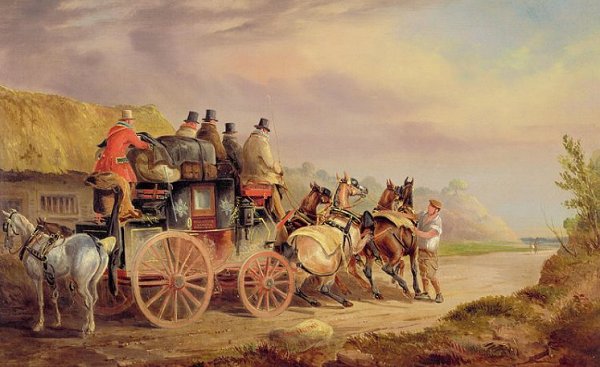
A painting of
the Quicksilver
Mail in "Mail
Coaches on the
Road - The
Quicksilver" by
Charles Cooper
Henderson.
As a staging
post for
coaches, the
Quicksilver Mail
maintained
stables at the
foot of Hendford
Hill in order to
assist with the
long, hard pull
to the top of
the hill by
adding another
trace of horses, which
was even more
difficult before
the inclines
were levelled
and a more
direct ascent
constructed. The
stables still
survive (see
photo below) and
are situated at
the rear of the
Railway Inn.
|
Yeovilians
remember...
|
Yeovil's Quicksilver Mail (referred to as the "Coach & Horses" in the 1861 census) is an eighteenth century inn and surely Fred Braine was its longest serving landlord with at least 41 years as licensee.
The following description is taken from the Somerset Historic Environment Record - "Inn, of C18 with later modifications. Ashlar Ham stonework, with Welsh slate roof between coped gables (two bottom courses of stone slates remain); brick chimney stacks at each end, that on South-west side widens at base, probably for oven. 2-storeys 3-bay facade, with (later) central doorway and 5 steps, crowned by shallow stone hood on modern brackets; on ground floor the sash windows to either side of the door had 20-panes: in each case the lower glazing bars removed: the windows set in architraves: the 3-first floor windows each have a central 12-pane window with 4-pane sidelight set in raised mullioned surrounds. Interior not inspected. The 'Quicksilver' was one of the fastest London mail coaches in the 1830's, which is said to have changed horses here. Originally 3-storey - lowest buried by raising of road level)."
During the Second World War, the Quicksilver Mail was earmarked as a Civil Defence Reinforcements Rendezvous Centre. In 1950 the skittle alley of the Quicksilver Mail was earmarked by the Corporation for use as a 'care of the homeless' furniture store in the case of a civil emergency - that is, the outbreak of another war.
|
New
faces at
Yeovil's
Quicksilver
Mail Yeovil Express & Star, 1 August 1996
|
![]()
Thomas Bullen is the first recorded licensee of the Quicksilver. He was born around 1796 at East Pulham, Dorset and in the 1841 census is recorded as an innkeeper on Hendford Hill with his wife, Harriett, and eight children. However, in the Notice of Letting in 1848 (shown below) it noted that the Quicksilver Mail was "now and for nearly 20 years past in the occupation of Mr Thomas Bullen". Thomas was still at the Quicksilver Mail in 1846 but left in 1848 when the inn was re-let y its owner, Thomas Symonds of Yeovil. in the 1851 census Thomas Bullen was living at Yew Tree Close with Harriett and two of their children. His occupation was listed as farmer of 78 acres. In fact, when looking at the 1846 Tithe Apportionment it becomes clear that Thomas Bullen actually rented Yew Tree Farm which included the Quicksilver Mail.
Interestingly the 1861 census lists the inn as the Coach and Horses Inn with the licensee, John Osmond, listed as a victualler and farmer of 80 acres (as with Thomas Bullen before him - did the pub and farm come as a package?). Kelly's Directory of that year corrected the mistake by referring to the Quicksilver Mail - perhaps the Coach and Horses was its colloquial sobriquet? Anyway, John Osmond was born on 15 April 1805 at Yetminster, Dorset, the son of James and Ann Osmond. He first appears in the Yeovil records in the 1851 census when he was listed as a victualler living on Hendford Hill with his wife, Mary Ann, of Chetnole, Dorset. There was also a servant and four visitors recorded. In the 1861 census, as noted above, John was listed as the licensee of the Coach and Horses. John died in 1863 aged 58.
In 1866 Kelly's Directory recorded Mrs Asenath Bishop as licensee. Asenath (a surprisingly common name in the early 1800's) Beck was born in Seavington around 1812, her mother's name was Dorcas but her father had died before the first census in 1841 and so remains unknown for the moment. By the 1841 census Asenath was aged 30 and living in Martock, Somerset. She had married Thomas Bishop (listed in the census as a 20-year old yeoman) and they had three children under the age of five; Dorcas, Thomas and James. By the time of the 1851 census ten years later, Asenath was naturally aged 40 but Thomas had mysteriously aged to become 55 instead of 30? The family were still living in Martock but it seems that baby James had died. There were, however, four more children; Anna, Joseph, Barbra and Mary. Thomas was described as an agricultural labourer and daughter Dorcas was a glover. By the following census in 1861 Thomas had died and Asenath was listed as being 46. She was living with her 82-year old mother in Martock, her mother being described as a landowner and Asenath as the housekeeper. Of Asenath's children, only 23-year old dressmaker Dorcas and 15-year old agricultural labourer Joseph were living with them. As mentioned above, in 1866 Asenath was listed in Kelly's Directory as the licensee of the Quicksilver Mail but by 1871 she was living in Belmont, Yeovil, with her son Thomas, daughter Barbra and granddaughter Anne.
The following licensee, Robert Dowding, was born on 9 April 1833 in Yeovil, the son of glover Charles Dowding and Frances, née Brailey. By 1841 Robert's mother had died and he and his younger brother, Charles, were living with their father in Ebenezer Row - a terrace of workers' houses at Townsend, roughly where Poundland is today. In the 1851 census, Robert was working as a porter in the shop of Daniel North in Tottenham Court Road, London, By 1861 he had returned to Ebenezer Row where he was living with his young wife, Fanny. Robert was working on the railway that had recently arrived in Yeovil and his occupation was given as railway plate layer. In 1871 he was listed as the innkeeper at the Quick Silver Mail Inn, where he lived with Fanny. I lost track of them in the records after this but they had left the Quicksilver by 1873.
There are only a couple of references to Francis Ackerman; a listing in Kelly's Directory of 1872 as landlord of the Quicksilver Mail and a court appearance in June 1873 in which Earle Vincent, brewer and owner of the Royal Osborne Brewery in Sherborne Road, sued Ackerman to recover a balance for drink supplied of £13 10s. Ackerman asked to pay at the rate of three shillings a month but the court ordered him to pay in full. He didn't stay landlord of the Quicksilver for long after that.
The next licensee, William Bicknell, had enjoyed a career as a Royal Marine and in the 1861 census was listed as a Royal Marine private at sea aboard HMS Trafalgar, a 120-gun first rate ship of the line of the Royal Navy, launched on 21 June 1841 at Woolwich Dockyard. She was the last to be completed of the successful Caledonia class. The ship was named by Lady Bridport, niece of Lord Nelson at the request of Queen Victoria, who with Prince Albert also attended the launch. The wine used was some kept from HMS Victory after returning from Trafalgar. Five hundred people were on board the ship at the time of its launch, of whom 100 had been at Trafalgar. William had been born in East Chinnock in 1827 and his wife, Elizabeth, was born in Haselbury Plucknett. In the 1871 census they were listed as living in Haselbury and William was described as a Plymouth Pensioner. By 1875 he was licensee of the Quicksilver Mail and in 1881 he was running the Heart of Oak in Huish. By the time of the 1891 census he was licensee of the Britannia Inn with Elizabeth. By 1901 William had died and Elizabeth was alone and 'living on her own means' in Orchard Street.
Charles Dodge was born in East Coker about 1822 but throughout his life he was something of a rover and was constantly moving his family around the country. In January 1844 he married Sarah Sherring Harris in Yeovil, but by the time of the 1851 census the couple were living in Covent Garden, London, where Charles was employed as a nailer (one who made iron nails by hand). By 1861 they had moved to Street, Somerset, where he was employed as a clicker (a shoemaker who cut out the leather for making the uppers) at the Boot & Shoe Factory. Charles and Sarah now had two sons, Frederick and Augustus Charles, known as Charles (both born in Yeovil), and two daughters, Caroline and Esther (both born in Street). In the mid-1860's the family were living in Blackheath, Kent, where their next son, Edwin, was born. The next couple of years saw another move and in 1871 Charles, still employed as a clicker, had moved his family to St Pauls, Bristol. Charles, Caroline and Edwin were all still living at home. In 1881 Charles had brought his family back to Yeovil and it was at this time that the census lists him as the innkeeper at the Quicksilver Inn. He was also listed by Whitby's Yeovil Almanack Advertiser the following year. He lived at the inn with Sarah and two of their daughters; Sarah (not previously recorded with the family but born around 1849 in Street) and Frances (also not previously recorded with the family but born around 1859 in Yeovil). In 1887 Sarah died and on 27 August 1889 Charles married Harriett Hurlstone back in Bristol (although she had been born in West Coker, just a mile or so from where Charles was born) - he was aged 67 and she was 70. Charles and Harriett lived in Yeovil and the 1891 census Charles was listed as a retired farmer (?) and they were living at Blue Cottage, Sherborne Road with Frances and Edwin. Charles died in Yeovil in 1906, aged 84.
John Bishop followed as landlord of the Quicksilver for a couple of years after Charles Dodge, but there were too many men of that name in Yeovil at the time to trace him with any certainty either before or after his tenancy.
I had a bit more luck tracing the more individually-named next licensee, Levi Vowles. Levi was born in Marston Magna around 1858, the son of Ambrose Vowles, a carrier born in Gillingham, Dorset, and his wife Susan, née Biddiscombe. In the 1871 census 13-year old Levi and his older brother, Herbert, were agricultural labourers while their two younger brothers, Arthur and Stephen, were at school. Levi's father died in 1876 and in the 1881 census Levi is listed as the head of the household with his mother and two younger brothers. Levi's occupation was listed as a carrier. In the summer of 1885 Levi married Hannah and by 1891 Levi was the innkeeper at the Quicksilver Mail where the census listed him with Hannah, two sons (William and Henry), two daughters (Ethel and Mary), a general servant and a nurse. Levi was listed as licensee of the Quicksilver in Kelly's Directory of 1895 but by 1901 the family had moved to East Coker, some three miles southwest of Yeovil. Levi was listed as an unemployed farmer and road contractor and was living with Hannah, Ethel, William and Henry, two more children; Sidney and Jessie, and a general domestic servant. By 1911 Levi, still a road contractor, had moved his family back to Yeovil where sons William and Henry were also described as contractors. Levi died in 1933, aged about 75.
Edwin Woodman was born about 1844 in Shirley, Dorset (now in Hampshire, about half-way between Christchurch and Ringwood) but there were quite a few Edwins around at the time and it is not possible to glean information on his early life. He is listed as licensee of the Quicksilver Mail between 1897 and 1903 and the 1901 census lists him living alone at the Quicksilver but with a servant. Edwin died in Yeovil in 1903.
The next licensee listed in the 1907 edition of the Yeovil Directory, C Beare, was probably Cuthbert, the son of James Beare, and certainly by 1911 James Beare was licensee of the Quicksilver Mail (see Gallery). James Beare came from a Yeovil-based publican family; his father, Hubert, had been licensee of the Beehive Inn, the Anchor Inn and the Albion Inn and James' grandfather, also called James Beare, and his grandmother, Johanna Beare, were licensees of the Beehive Inn from the 1840's until the 1860's. James was born in 1858, probably in the cottage adjoining the old Pen Mill Inn where his parents lived at the time. By the time of the 1871 census James was living with his parents and younger siblings (he was the eldest child of the family) in the Beehive. At the time of the following census in 1881, James was a police constable living in the 'Police Constable's House' in Melbury Abbas, Dorset, with his wife, Susan, née Tanner, two-year old son H Jerrold (Hurbert Gerald) and one-year old Cuthbert. Both the boys had been born in Yeovil. Some time after 1886 there was another move and another job; in the 1891 census James had moved his family to Limington, six miles north of Yeovil where they were living in the cottage adjoining the Lamb & Lark pub. James now had a daughter, Laura, also known as Lauretta. His occupation was listed as a coal merchant and he was most likely working for his coal merchant father in Yeovil. By 1901 the family had moved yet again, this time to Odcombe, four miles west of Yeovil where James became the publican of the village pub. Herbert was described as a road contractor, Cuthbert as a pianoforte maker and Lauretta as a barmaid. In 1907, as noted above, C Beare was listed in the Yeovil Directory as licensee of the Quicksilver Mail - Cuthbert was the only C Beare in the area and it is possible that he was holding the pub until his father could take over as, certainly by 1911, James was the Quicksilver's licensee. The 1911 census is quite interesting; James, aged 53, was listed as hotel and yeoman, Susan, aged 55, was listed as an assistant in the business and Cuthbert, aged 31 and single, as a pianoforte repairer. Henry Beare (James' brother) and Laura were listed as visitors. James and Susan had been married for 32 years and had had eight children, five of whom had died (and, presumably, had not been present at the times of the various censuses). Also Laura was now married and her married name was Braine. She had married Frederick George Braine, the grandson of Charity Braine who ran the Greyhound Inn in South Street during the 1890's but see below for more about Frederick Braine. The final listing of James Beare as licensee of the Quicksilver was in Whitby's Yeovil Almanack Advertiser of 1916. James died in 1917 aged about 58.
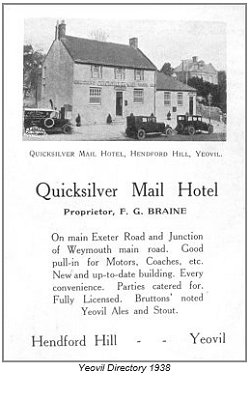 Now,
really
concentrate,
as this is where
it gets somewhat
complicated and
inundated with a
variety of Freds.
Now,
really
concentrate,
as this is where
it gets somewhat
complicated and
inundated with a
variety of Freds.
So.... Charity Parsons married George Frederick Braine and after George Frederick's death Charity became licensee of the Market House Inn, South Street. One of George Frederick and Charity's children was Frederick John Braine who married Annie Treasure. Frederick John Braine died in 1897 and his widow, Annie, married Frederick Langdon, licensee of the Cow Inn next door to the Greyhound, in 1898. The couple ran both pubs until Fred Langdon's death in 1906 after which Annie, now Annie Langdon, ran the Greyhound.
Frederick John Braine and Annie's son, Frederick George Braine, married Laura Beare who was the daughter of James Beare, the licensee of the Quicksilver Mail (see above) and after James Beare's death in 1917, Fred and Laura ran the Quicksilver until the 1960's. Got it?
MAP
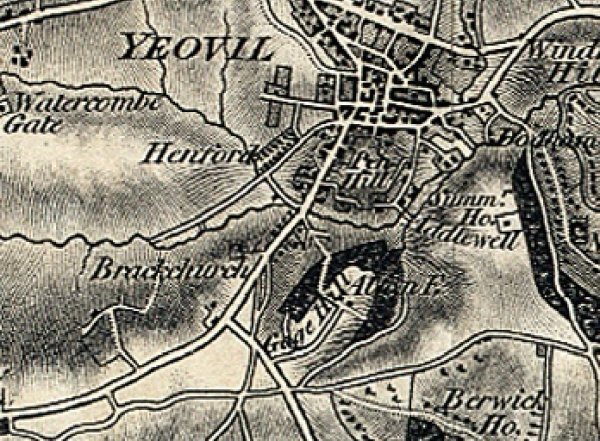
Probably the earliest map showing the whole of Hendford Hill - the 1811 Ordnance Survey map. The only building shown is the Quicksilver Mail, at the top of the hill, which still stands today.
Sketch Plan of the Quicksilver Mail
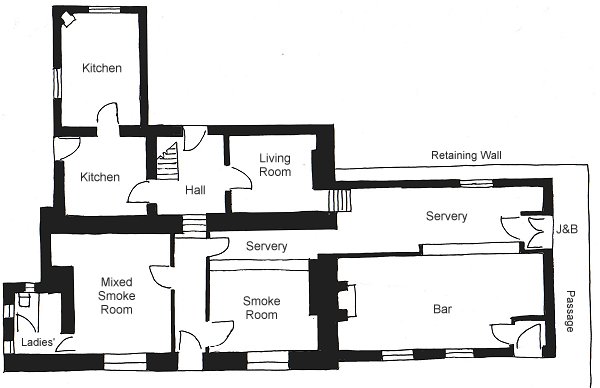
This is a sketch based on plans held at the Heritage Centre, Taunton. The original plans are dated 1939 when the owners were Brutton, Mitchell Toms Ltd. The top kitchen was a single storey lean-to building while the bar and servery at right were single storey under a pitched roof. Comparing this plan of 1939 with the advertising photograph of 1938 above, it would appear that the ladies' toilet off the mixed smoking room was added in the intervening period - giving a possible indication of when women began to frequent in increasing numbers.
gallery
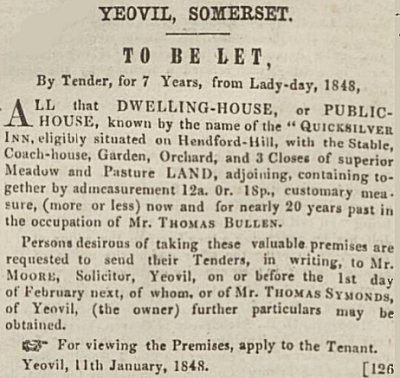
This notice of letting was placed in the 22 January 1848 edition of the Sherborne Mercury, indicating that the inn had been in operation since the late 1820s at least "now and for nearly twenty years past in the occupation of Mr Thomas Bullen".
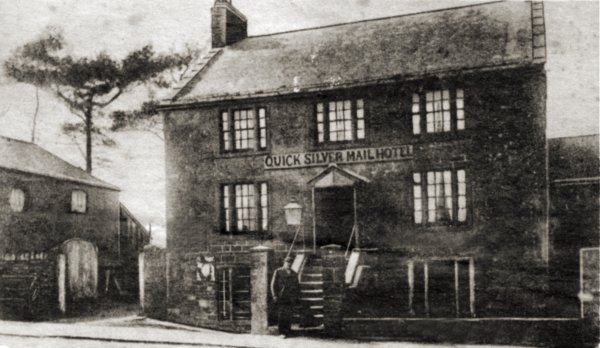
Courtesy of Viv
Cafferkey
The Quick Silver Mail Hotel (as three storeys) photographed between 1911 and 1916 when James Beare was licensee - and that's him in the photo.
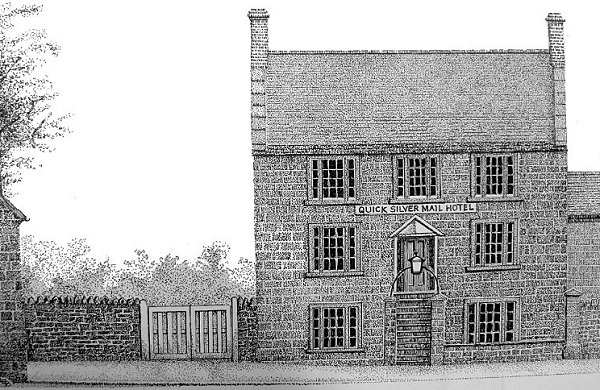
The three-storey Quicksilver Mail before the road level was raised - drawing by Leslie Brooke.
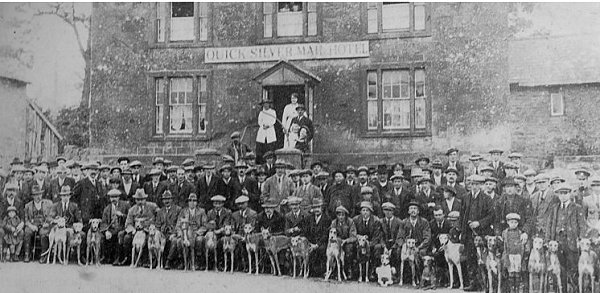
This photograph, taken outside the Quicksilver Mail, possibly dates to about 1930 - when greyhound racing in Yeovil was held at Barwick Field.

From my
collection
-
This
colourised photograph
features in my
book 'Yeovil From Old Photographs'.
The Quicksilver Mail photographed in the 1930's, when you could actually park outside...
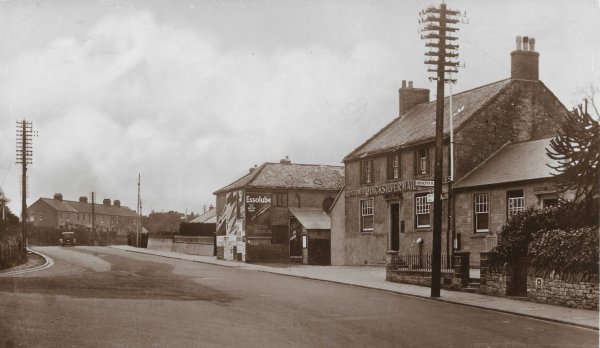
Courtesy of Alan
Jackson
The Quicksilver Mail in a photograph of 1932, taken from the junction

... and in a colourised photograph of the 1960's - note the air raid siren by the chimney at left..
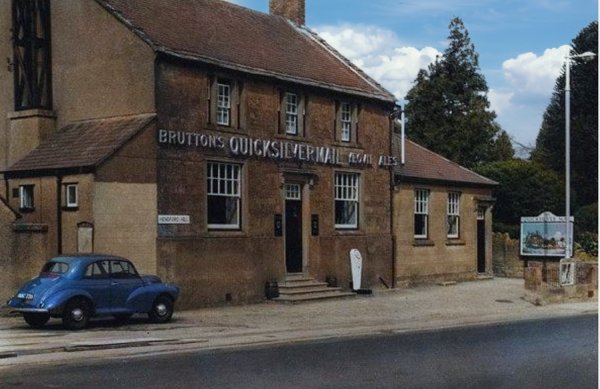
A colourised photograph of 1960 by Charrington & Co Ltd's surveyors as part of a 'stocktaking' exercise of photographing Brutton's pubs prior to the brewery takeover.
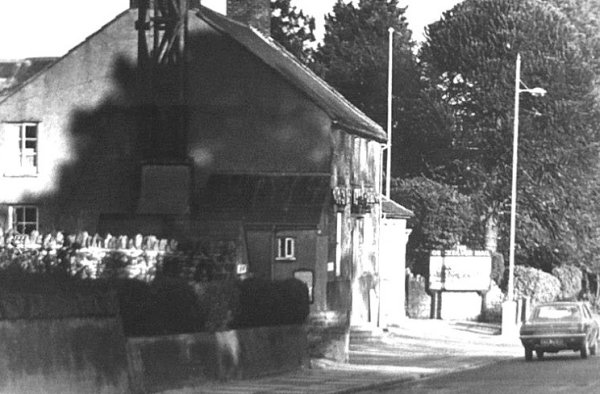
Photographed by
Geoff Bowler,
courtesy of Sue
Bowler
...and seen from the West Coker Road in 1969. Note the air raid siren surmounting the wooden structure on the side of the building.
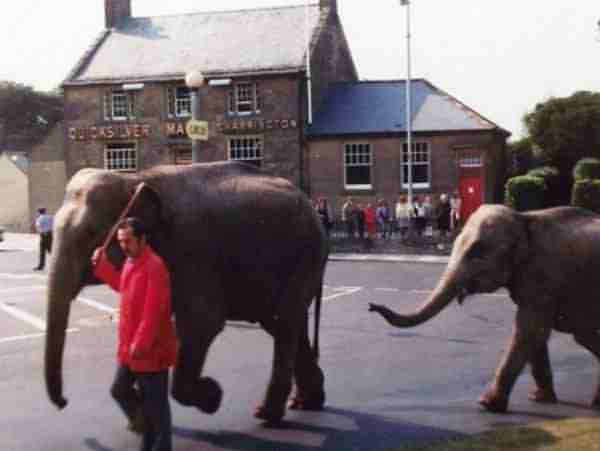
Unusual pedestrians pass by the Quicksilver in the 1970s, en route for Yeovil Showground.
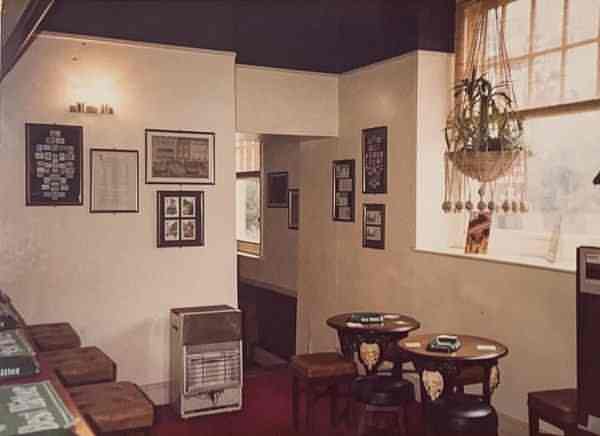
Courtesy of Mike
Cannon
The Quicksilver Mail 'top bar', photographed in September 1985.
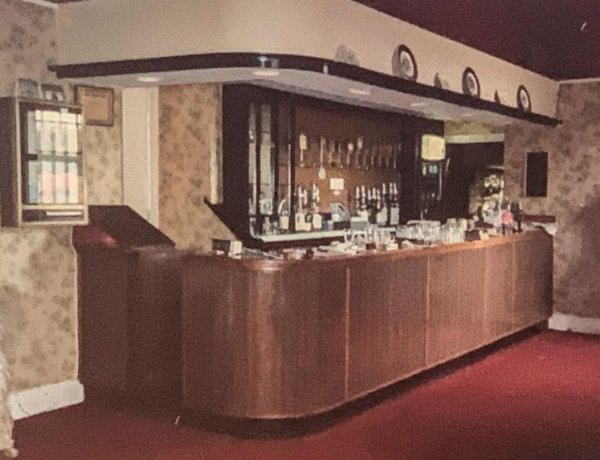
Courtesy of Mike
Cannon
The Quicksilver Mail 'top bar', again photographed in 1985, when Mike became landlord.
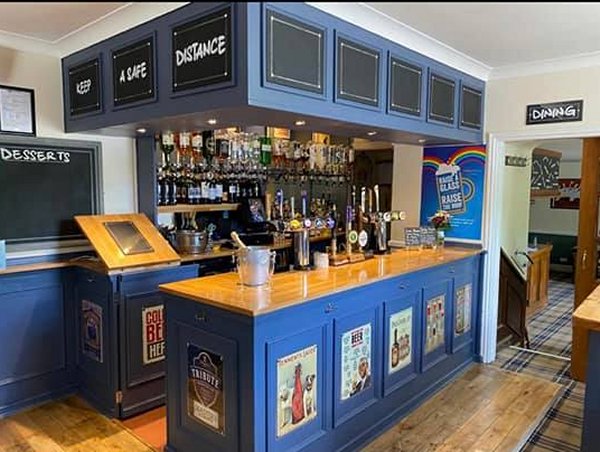
Courtesy of Pete
Lambden
... the same scene today.
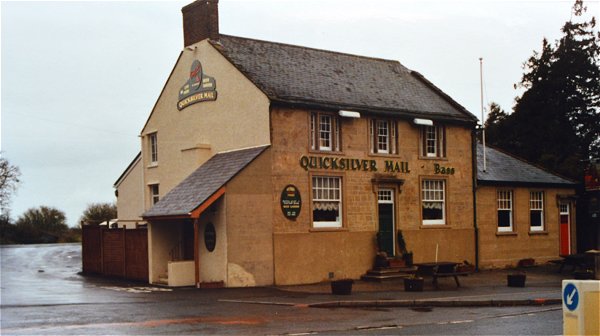
Courtesy of
Chris Rendell
The Quicksilver Mail photographed in 1989.
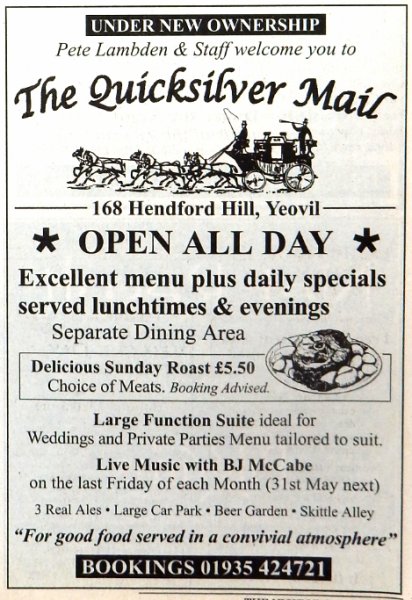
From my
collection
A 2002 advertisement from The Visitor.
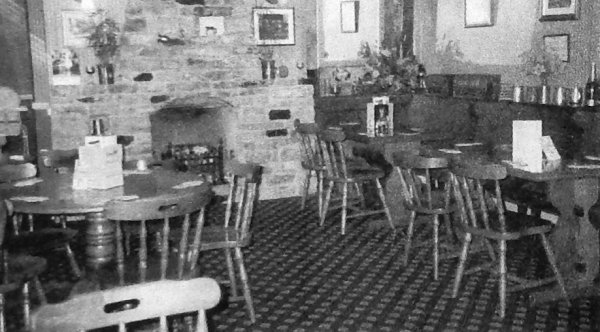
From my
collection
A 2002 publicity shot of the lounge bar from The Visitor.
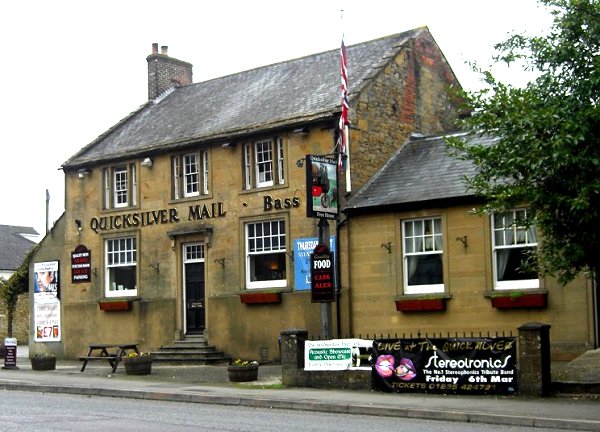
Photographed in 2009.
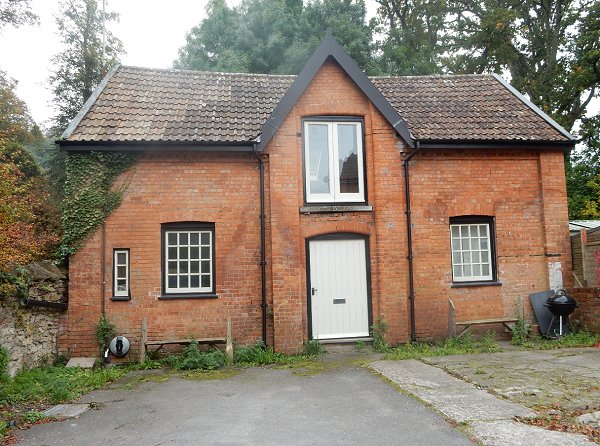
The front of the stable block at the bottom of Hendford Hill, behind the Railway Inn, at one time owned by the Quicksilver Mail in order to assist with the long, hard pull of horse-drawn mail coaches to the top of the hill by adding another trace of horses to pull the coaches. Photographed in 2016.
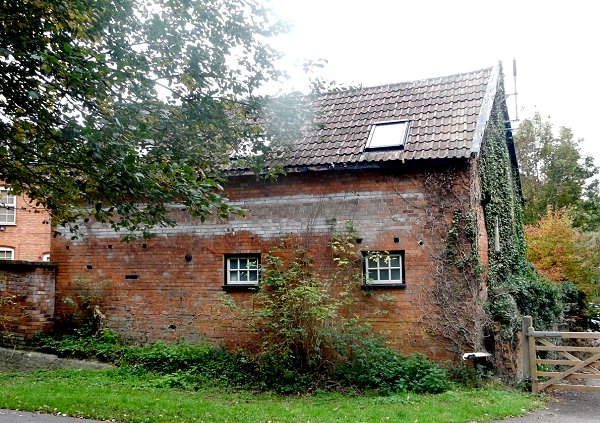
The rear of the stable block seen from the line of the old Yeovil-Durston railway, now the footpath running alongside Ninesprings. Photographed in 2016.
licensees
c1828 – Thomas
Bullen (noted in
1848 as licensee
"for nearly 20
years past").
1841 – Thomas
Bullen –
Innkeeper (1841
census) pub not
named
1846 – Thomas
Simmonds, owner
– Thomas Bullen,
occupier (Tithe
Apportionment)
listed as
The Inn &
Garden, Hendford
Hill
1850 – James
Osment (sic) –
Beer Retailer
(Hunt & Co's
1850 Directory)
1851 – John
Osmond –
Victualler (1851
census) pub not
named, on
Hendford Hill
1861 – John
Osmond (Kelly's
1861 Directory)
listed as
Quicksilver Mail
1861 – John
Osmond –
Victualler &
Farmer (1861
census) listed
as Coach &
Horses Inn
1866 – Mrs
Asenath Bishop
(Kelly's 1866
Directory)
1867 – Frederick
Vickery - fined
for selling
drink before
noon on Sunday
(Petty Sessions)
1868 – Licensee
not named,
license
suspended for
one month (Petty
Sessions)
1871 – Robert
Dowding – Inn
Keeper (1871
census) listed
as Quick Silver
Mail Inn.
1872
– R Dowding -
License transfer
(Borough Petty
Sessions, March)
1872 – F Akerman
- License
transferred
(Borough Petty
Sessions, March)
1872 – Francis
Ackerman
(Kelly's 1872
Directory -
Hotels & Inns)
1875 – William
Bicknell
(Kelly's 1871
Directory -
Hotels & Inns)
1875 – William
Bicknell (1875
Post Office
Directory)
1881 – Charles
Dodge – Inn
Keeper (1881
census) listed
as Quicksilver
Inn
1882 – Charles
Dodge (Whitby's
1882 Yeovil
Almanack
Advertiser)
1885 – Edward
Brown - License
transfer
(Borough Petty
Sessions,
November)
1885 – John
Bishop - License
transferred
(Borough Petty
Sessions,
November)
Bishop had
come from the
King's Arms,
Silver Street
1889 – John
Bishop (Kelly’s
1889 Directory)
listed as
Quicksilver Mail
1890 – John
Bishop (Kelly’s
1890 Directory)
listed as
Quicksilver Mail
1891 – Levi
Vowles – Inn
Keeper (1891
census) listed
as Quick Silver
Mail
1895 – Levi
Vowles (Kelly’s
1895 Directory)
listed as
Quicksilver Mail
PH
1897 – Edwin
Woodman (Kelly’s
1897 Directory)
listed as
Quicksilver Mail
1901 – Edwin
Woodman –
Innkeeper (1901
census) listed
as Quicksilver
Mail
1902 – E Woodman
(Kelly’s 1902
Directory)
listed as
Quicksilver Mail
1903 – Edwin
Woodman
(Whitby's 1903
Yeovil Almanack
Advertiser)
1907 – C Beare
(1907 Yeovil
Directory)
1911 – James
Beare (1911
census) listed
as Quicksilver
Mail
1916 – James
Beare (Whitby's
1916 Yeovil
Almanack
Advertiser)
1919 – Frederick
Braine (Kelly’s
1919 Directory)
listed as
Quicksilver Mail
1923 – Frederick
Braine (Kelly’s
1923 Directory)
listed as
Quicksilver Mail
PH
1936 – FGW
Braine (1936
Yeovil
Directory)
listed as Quick
Silver Mail
1938 – FGW
Braine (1938
Yeovil
Directory)
listed as Quick
Silver Mail
Hotel
1939 – Frederick
Braine (Kelly’s
1939 Directory)
listed as
Quicksilver Mail
PH
1947 – FG Braine
(1947 Yeovil
Directory)
listed as Quick
Silver Mail
1949 – FG Braine
(Kelly’s 1949
Directory)
listed as Quick
Silver Mail
1951 – FG Braine
(1951 Yeovil
Directory)
listed as Quick
Silver Mail
1954 – FG Braine
(1954 Yeovil
Directory)
listed as Quick
Silver Mail
1957 – FG Braine
(1957 Yeovil
Directory)
listed as
Quicksilver Mail
1960 – FG Braine
(1960 Yeovil
Directory)
listed as
Quicksilver Mail
1965 – Licensee
not named (1965
Yeovil
Directory)
listed as
Quicksilver Mail
1968 – Licensee
not named
(Kelly’s 1968
Directory)
listed as
Quicksilver Mail
1969 – Licensee
not named
(Kelly’s 1969
Directory)
listed as
Quicksilver Mail
1970 – Licensee
not named
(Kelly’s 1970
Directory)
listed as
Quicksilver Mail
1971 – Licensee
not named
(Kelly’s 1971
Directory)
listed as
Quicksilver Mail
1972 – Licensee
not named
(Kelly’s 1972
Directory)
listed as
Quicksilver Mail
1972 to 1982 -
Ray and Joy
Clark
1973 – Licensee
not named
(Kelly’s 1973
Directory)
listed as
Quicksilver Mail
1974 – Licensee
not named (1974
Yeovil
Directory)
listed as
Quicksilver Mail
1985 to 1991 -
Mike Cannon
1987 – Licensee
not named
(Denton’s 1987
Directory)
listed as
Quicksilver Mail
1991 to 1996 -
Nigel Manning
1996 to March
2002 - Dave &
Yvonne Anderson
(newspaper
article above)
2002 to present
- Pete Lambden

